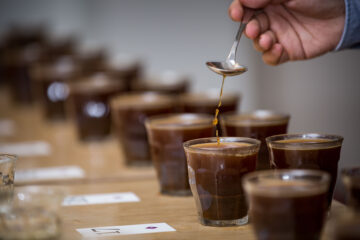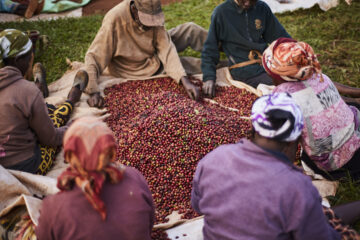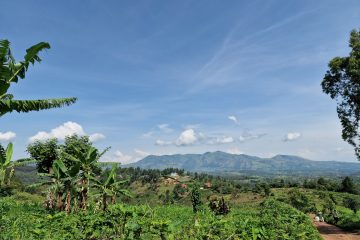
2013 Purchase
This year we took three trips to Kenya all together to follow up with our partners and select the cream of the crop. We have so far bought a great bunch of AAs and ABs and some are already shipped. The coffees are carefully selected and totally meet our requirements for what stand-out Kenyans should taste like. We will have some samples to be sent out soon. First come, first serve!
The first shipment will at least contain the following coffees, and should arrive and be available for purchase from end of April if all goes well.
AA Gichatthaini Lot 008 (Gikanda Coop) 72 boxes of 30 kg
AA Thunguri Lot 202 (Rumokia Coop) 56 boxes of 30 kg
AB Gichathaini 008 (Gikanda Coop) 50 bags of 60 kg
AB Karogoto Lot 255 (Tekangu Coop) 50 boxes of 30 kg
*The lot number refers to the specific batch/outturn number from the wet mill/factory.
*Gichatthaini AA and AB lot 08 is the different screen sizes from the same outturn
Second container will at least contain:
AA Gichatthaini lot 081 (Gikanda Coop) 34 boxes of 30 kg
AA Thunguri lot 154 (Rumokia Coop) 50 boxes of 30 kg
AA Tegu lot 164 (Tekangu Coop) 30 boxes of 30 kg
AA Karindundu lot 229 (Barichu Coop) 36 boxes of 30 kg
AA Kagunyo lot 156 (Rumokia Coop) 36 boxes of 30 kg
AB Gichatthaini lot 081 (Gikanda Coop) 50 bags of 60 kg
AB Kagunyo lot 156 (Rumokia Coop) 50 bags of 60 kg
AB Kangocho lot 088 (Gikanda Coop) 50 bags of 60 kg
More TBA
—————————————————————————————————————————

Timing is everything
In Kenya it is all about correct timing when it comes to cupping for purchasing.
My first visit this season was in December, and there was hardly anything to cup other than coffees from larger estates. As we’ve mentioned before, we generally find the coffees from Nyeri and Kirinyaga (where there are mainly cooperatives) more attractive. Normally there are some good amounts of coffees from the co-ops by this point, but the harvest this year was slightly delayed.
Tim went back in mid-January and was able to cup enough to see the general potential for this season, which was promising, but it was still too early to actually pick and choose from the wet mills and co-ops we work with.
Finally I was there with a group of clients tagging along on a longer Africa trip in February, and the timing was perfect. A lot of the coffees from our preferred co-ops and wet mills were just coming in to the dry mill and we had a lot of great stuff to choose from.

One Co-op, different wet mills, and a bunch of different coffees
I’ve had many questions the past year regarding if our coffees like Tegu, Karogoto or other well known Factory names is the same coffee as other roasters have. In general I would say no – normally, (and especially for the AAs and PBs), we are buying the total amount of an outturn when we find something we like.
As many of you know, the Cooperative structure in Kenya is organized in a way where you have the Cooperative Society as the umbrella organization e.g. Gikanda Cooperative Society. A Cooperative Society can have everything from one to six different factories (wet mills) The name “Gikanda,” for instance, is the short version and a combination of the names of the three factories (wet mills) under that Co-op: Gichatthaini, Kangocho, and Ndaorini. Another example is Tekangu Cooperative Society, which comes from combining Tegu, Karogoto, and Ngunguru.
There is no such thing as one “Tekangu Coffee” or even one “Karogoto Coffee” unless you specifically ask an exporter to blend all the different outturns for you. Meaning every Cooperative, wet mill, or even Estate will deliver many different outturns that are kept and sold separately. That’s the beauty of the Kenyan coffee industry. The trade of quality is mainly based on lot separation.

Selection through cupping
Back to why timing is important: If you plan only one trip during the season, book your ticket too early, and only have a couple of days to cup, what you will be able to access and cup through during those days is really random. That’s why we almost always do at least two or three trips post-harvest.
The coffees received and processed at the cooperative wet mills in Kenya are normally kept in conditioning bins at the wet mill’s warehouse until the factory manager decides to deliver that specific outturn to their dry miller and marketing agent. This can take a while after harvest, since in Kenya they often take the coffees into conditioning at what they call the black stage, meaning when the coffees are stable at 15-16% moisture, but still not totally dried to the target of 11 – 11,5%.
Some do it because they believe it’s good for the quality, but it’s also a matter of logistics, as they will get free space on the drying tables for new coffees coming in. This can in our opinion benefit the coffees anyway, as they get a resting period during drying, but it can create delays on parchment delivery after harvest. When they have free space on the tables, they then finish of the drying down to 11% before delivery of the parchment to the dry mill. They will also normally spend some time to handpick and sort their coffees before they are delivered.
All the Co-ops we work with are then delivering several different lots from each wet mill.
Even from the top Co-ops and wet mills you will have some great coffees, some mediocre stuff and normally some basic commercial outturns. It’s a shame to hear this kind of misperception from people that have cupped one outturn from a wet mill, e.g. “Kangocho is not cupping well this year” … !!?

Direct — before the auction
When we are there to cup at the right time, when the good wet mills are delivering their best outturns to be milled or if they are recently milled and graded, we will normally have the first right of refusal for the coffee. If we commit while we are there it can be pulled out from the auction catalogue or sold to us even before it’s registered for the auction. If we are not there it can either go to the auction and be available for everyone, or there might be other buyers cupping and buying that coffee before we even get the chance to get a sample sent. That’s the name of the game.
That said, as we are working in a close relationship with the wet mills, marketing agents and exporters. We do have some priority on some of the Co-ops, and will always be able to access coffees direct from the Co-ops without having to go through auction. There is nothing wrong with the auction system, either — it is transparent and the money mainly goes back to the farmer anyway — but the fact is that the co-ops we work with are attractive and the best lots will hardly ever reach the auction room.


